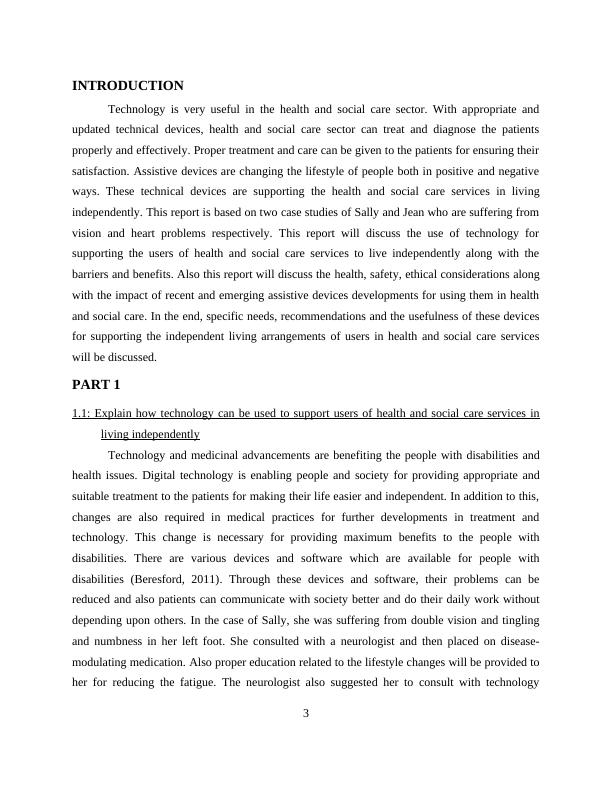Supporting independent living in the context of health and social care technologies
12 Pages4095 Words103 Views
Added on 2020-10-22
About This Document
SUPPORTING INDEPENDENT LIVING INTRODUCTION 3 PART 13 1.1: Explain how technology can be used to support users of health and social care services in living independently 3 1.2: Analyze barriers to the use of technology to support users of health and social care services in living independently known4 1.3: Explain the benefits of these technologies to health and social care organisations and their users 5 2.1: Explain health and safety considerations in the use of technologies in health and social care 6 2.2: Discuss ethical considerations in
Supporting independent living in the context of health and social care technologies
Added on 2020-10-22
ShareRelated Documents
SUPPORTINGINDEPENDENTLIVING1

Table of ContentsINTRODUCTION...........................................................................................................................3PART 1............................................................................................................................................31.1: Explain how technology can be used to support users of health and social care services inliving independently...............................................................................................................31.2: Analyze barriers to the use of technology to support users of health and social careservices in living independently.............................................................................................41.3: Explain the benefits of these technologies to health and social care organisations and theirusers........................................................................................................................................52.1: Explain health and safety considerations in the use of technologies in health and socialcare.........................................................................................................................................62.2: Discuss ethical considerations in the use of assistive technologies................................62.3 Explain the impact of recent and emerging technological developments on health andsocial care services, organisations and care workers..............................................................7Part 2................................................................................................................................................83.1: Identify Jane’s specific needs in order to support Jane to live independently................83.2: Make your own recommendations on how the Technology might support her independentliving arrangements................................................................................................................93.3 Evaluate the usefulness of technology for Jane and also for other users of health and socialcare services............................................................................................................................9CONCLUSION..............................................................................................................................10REFERENCES..............................................................................................................................112

INTRODUCTIONTechnology is very useful in the health and social care sector. With appropriate andupdated technical devices, health and social care sector can treat and diagnose the patientsproperly and effectively. Proper treatment and care can be given to the patients for ensuring theirsatisfaction. Assistive devices are changing the lifestyle of people both in positive and negativeways. These technical devices are supporting the health and social care services in livingindependently. This report is based on two case studies of Sally and Jean who are suffering fromvision and heart problems respectively. This report will discuss the use of technology forsupporting the users of health and social care services to live independently along with thebarriers and benefits. Also this report will discuss the health, safety, ethical considerations alongwith the impact of recent and emerging assistive devices developments for using them in healthand social care. In the end, specific needs, recommendations and the usefulness of these devicesfor supporting the independent living arrangements of users in health and social care serviceswill be discussed.PART 11.1: Explain how technology can be used to support users of health and social care services inliving independentlyTechnology and medicinal advancements are benefiting the people with disabilities andhealth issues. Digital technology is enabling people and society for providing appropriate andsuitable treatment to the patients for making their life easier and independent. In addition to this,changes are also required in medical practices for further developments in treatment andtechnology. This change is necessary for providing maximum benefits to the people withdisabilities. There are various devices and software which are available for people withdisabilities (Beresford, 2011). Through these devices and software, their problems can bereduced and also patients can communicate with society better and do their daily work withoutdepending upon others. In the case of Sally, she was suffering from double vision and tinglingand numbness in her left foot. She consulted with a neurologist and then placed on disease-modulating medication. Also proper education related to the lifestyle changes will be provided toher for reducing the fatigue. The neurologist also suggested her to consult with technology3

specialist for providing the information and education about the assistive devices which areavailable for her. With the use of these assistive devices, her problems can be reduced to a lowerextent through which she can drive to and from work and also to help her children in doing theirafter school activities such as games and homework (Campbell and Oliver, 2013).She was referred to Occupation Therapist for the diagnosis of her ankle-foot orthosis andalso refereed to Assistive Technology Specialist for considering the other available alternativesfor facing her various issues related to typing, holding lunch tray, and for performing other dayto day life activities (Cogan, 2014). Her general practitioner told her to consult with driver'strainer specialist in order to modify her vehicle with a special type of spinner knob andaccelerator with left foot and also to provide her training for new way of driving with thesemodifications. Also the GP told her to consult with a social worker for taking counselling andsupport related to work, finances and decisions taken for her personal life. She was providedwith a handheld devices known as personal digital assistant (PDA) after a cognitive evaluationbased on her memory skills for aiding her in memory skills. From this device, she needs to pusha single button for remembering what to do next and also this device is helpful for her to do herdaily activities. From this device, she can manage her work related to healthcare, medicationsand nutritional supplements. 1.2: Analyze barriers to the use of technology to support users of health and social care servicesin living independentlyThere are different types of barriers which can affect the patients in taking appropriatetreatment such as budget, deficiency of internal resources, resistance to technology, knowledgebarriers etc. Assistive technology is a good tool for reducing the dependency of disabled personto take the medicines, care and also for performing their daily work (Dadlani and et. al., 2011).Technology use helps such patients and it is also available throughout the day. In the case ofSally, she can continue to do her daily work with the use of assistive technology. Her visionproblem is solved by using enlarged keyboard with extra dark character on it for ensuring thatshe will work with her full efficiency. Through these assistive devices, People like Sally cancontinue to do their job and also can help their children in after school activities. These deviceshave benefits as well as some limitations also along with several technical as well as socialbarriers. Some of the barriers will be discussed further. 4

End of preview
Want to access all the pages? Upload your documents or become a member.
Related Documents
Supporting Independent Living (doc)lg...
|11
|3772
|394
Supporting Independent Living: Assignment Samplelg...
|12
|4288
|29
Health and Social Carelg...
|22
|4686
|226
Supporting Independent Living - Sampe Assignmentlg...
|12
|3945
|21
Supporting Independent Living | Assignmentlg...
|12
|4252
|37
Supporting Independent Living Reportlg...
|12
|4042
|31
